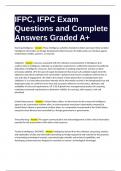IFPC, IFPC Exam
Questions and Complete
Answers Graded A+
Warning Intelligence - Answer: Those intelligence activities intended to detect and report time sensitive
intelligence information on foreign developments that forewarn of hostile actions or intention against
United States entities, partners, or interests.
Validation - Answer: A process associated with the collection and production of intelligence that
confirms that an intelligence collection or production requirement is sufficiently important to justify the
dedication of intelligence resources, does not duplicate an existing requirement, and has not been
previously satisfied. (JP 2-0) A part of target development that ensures all candidate targets meet the
objectives and criteria outlined in the commander's guidance and ensures compliance with the law of
war and rules of engagement. (JP 3-60) In the context of time-phased force and deployment data
validation, it is an execution procedure whereby all the information records in the timephased force and
deployment data are confirmed error-free and accurately reflect the current status, attributes, and
availability of units and requirements. (JP 3-35) A global force management procedure for assessing
combatant command requirements to determine viability, for sourcing, with respect to risk and
prioritizati
United States person - Answer: A United States citizen; an alien known by the concerned intelligence
agency to be a permanent resident alien; an unincorporated association substantially composed of
United States citizens or permanent resident aliens; or a corporation incorporated in the United States,
except for those directed and controlled by a foreign government or governments.
Threat Warning - Answer: The urgent communication and acknowledgement of time-critical information
essential for the preservation of life and/or vital resources.
Technical Intelligence (TECHINT) - Answer: Intelligence derived from the collection, processing, analysis,
and exploitation of data and information pertaining to foreign equipment and materiel for the purposes
of preventing technological surprise, assessing foreign scientific and technical capabilities, and
developing countermeasures designed to neutralize an enemy's technological advantages.
,tear line - Answer: A visible line on an intelligence message separating categories of information that
have been approved for foreign disclosure and release.
task force counterintelligence coordinating authority - Answer: An individual in a joint force intelligence
directorate, counterintelligence and human intelligence staff element, joint task force configuration that
coordinates counterintelligence activities with other Glossary GL-24 JP 2-0 supporting
counterintelligence organizations and agencies to ensure full counterintelligence coverage of the task
force operational area.
Target Area of Interest (TAI) - Answer: The geographical area where high-value targets can be acquired
and engaged by friendly forces.
Tactical Exploitation of National Capabilities (TENCAP) - Answer: A program exploiting national
capabilities and integrating those capabilities into the tactical decision-making process.
synchronization - Answer: The arrangement of military actions in time, space, and purpose to produce
maximum relative combat power at a decisive place and time. 2. In intelligence usage, application of
intelligence sources and methods in concert with the operation plan to answer intelligence
requirements in time to influence the decisions they support.
structured observation management (SOM) - Answer: The framework for standardizing how geospatial
intelligence observations are captured, organized, and shared.
Strategic Intelligence - Answer: Intelligence required for the formation of policy and military plans at
national and international levels.
source registry - Answer: The collection, from, by, and/or via humans, of foreign and military and
military-related intelligence.
Source Operations - Answer: The collection, from, by, and/or via humans, of foreign and military and
military-related intelligence.
, source management - Answer: The process to register and monitor the use of human sources to protect
the security of the operations and avoid conflicts.
source - Answer: 1. A person, thing, or activity from which information is obtained. 2. In clandestine
activities, a person (agent), normally a foreign national, in the employ of an intelligence activity for
intelligence purposes. 3. In interrogation activities, any Glossary GL-23 person who furnishes
information, either with or without the knowledge that the information is being used for intelligence
purposes.
sociocultural factors - Answer: The social, cultural, and behavioral factors characterizing the
relationships and activities, informal and formal power structures, laws and policies, access to resources,
and decision making of the population of a specific region or operational environment.
sociocultural analysis (SCA) - Answer: The analysis of enemies, adversaries, and other relevant actors
that integrates gender-based and cultural norms and beliefs of societies, populations, and other groups
of people, including their activities, informal and formal power structures, laws and policies, access to
resources, and decision making across time and space at varying scales.
Situation Template - Answer: A depiction of assumed adversary dispositions, based on that adversary's
preferred method of operations and the impact of the operational environment if the adversary should
adopt a particular course of action.
signals intelligence operational tasking authority (SOTA) - Answer: A military commander's authority to
operationally direct and levy signals intelligence requirements on designated signals intelligence
resources.
Signals Intelligence (SIGINT) - Answer: 1. A category of intelligence comprising all communications
intelligence, electronic intelligence, and foreign instrumentation signals intelligence, however
transmitted, individually or in combination. 2. Intelligence derived from communications, electronic, and
foreign instrumentation signals.
sensitive compartmented information facility (SCIF) - Answer: An accredited area, room, group of rooms,
or installation where sensitive compartmented information may be stored, used, discussed, and/or
electronically processed, whereby procedural and physical measures prevent the free access of persons
unless they have been formally indoctrinated for the particular sensitive compartmented information
authorized for use or storage within that facility.




